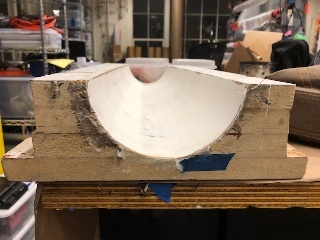Above: Hermes 1 nose cone mold (4 layers of 1" thick MDF, sanded and finished with gel coat), manufactured by Raul Largaespada.
...
- 3/4" or 1" thick MDF (we used 3/4")
- Epoxy (WHAT KIND)
- Pins (??)
- Ruler
- Router
- Table saw or Bandsaw
- PPE: safety goggles, gloves
Procedure
- Created design of mold in Solidworks (using "Solidworks mold tools" --> helpful tutorial: https://youtu.be/yqROZFStz6c) and save as an .STL file.
- Calculated how much MDF needs to be used (based on thickness, dimensions of nose cone). Make sure to account for extra area for pry slits and alignment pins.
- Cut the MDF using a bandsaw and glued together (using what epoxy?). The piece of MDF we used was 25" x 97" so it required two people to cut it on the bandsaw because it was so large. It would be better to use a table saw to get the sides more even so that aligning the mold on the router will be easier.
- Mark where pry slits and alignment pins go.
- Verified that the tool head would not run into the wall of the nose cone while routing (this can happen if you're cutting too steep of an angle: see image below)
- Find some way to clamp the mold to the router table (if it moves around while routing, the mold will be ruined). Since we already glued the pieces of MDF together we decided to attach L-brackets to the side of the mold so that it can be bolted to the router table. We forgot to plan for this ahead of time so it was annoying and we had to increase the size of the holes in the L-brackets to fit the screws that attach to the table. An alternative would be to cut slots in the MDF before you glue the layers together so that it can be clamped down.
- When routing:
- Make sure the router is routing the correct shape- pause if necessary (instead of stopping the router altogether, set the speed to 1% so you don't have to re-zero everything after. It won't technically be "stopped" but it will be moving very slowly so you're effectively pausing it)
- Lots of sawdust will be generated, so follow the router tip with a vacuum to get most of it.
...
- Fiberglass (5.7 oz S-glass)
- Epoxy (Fibreglast 3000)
- Wax
- Fibrelease
- Phenolic microballoons
- Spray gun
- Squeegees
- Acetone
- Epoxy boats
- Popsicle sticks
- Spear tool
- Scissors
- PPE: gloves
Procedure
- Cut fiberglass layers and vacc bag (HOW BIG) the day before layup (smoothed fiberglass in mold, taped down, drew lines, accounted for tab and cut out 20 identical)
- Applied Fibrelease
- Prepped ablative coating (15% by weight phenolic microballoons --> SHOW 3 EQUATIONS USED)
- Degassed ablative coating mixture (put it in a vacuum pump for ~20 minutes, or until bubbles stopped forming). Make sure it's in a large container because it expands a lot when you degas it.
- Applied ablative coating
- degassed phenolic mixture
- applied to mold (not recommended, this should be done afterwards next time)
- Started layup --> first plies weren't wet enough, so make sure you're not skimping on epoxy
- apply starting from the tip, lining up one end flush with the mold (use same side for each half --> align it well the first time because it's difficult to cut)
- Smooth SLOWLY and don't put down more fiber until bubbles are gone
- Attach halves, make sure fibers not caugt in sides
- Shine light on one end
- Use rod tool to smooth fibers from each end
- Apply two extra strips along seams (two on each seam) and smooth with tool and by hand for good measure. Cut end of strip so it's not on linear coupler section because this will make it easier to sand later
- peel ply difficult to apply, use blue tape
- use cone shape for rest of vacc bagging materials (taped narrow end to rod and pushed it in, worked pretty well)
- took a while to find bubbles for vacc bag
...
- Spear tool (two pieces of disposable squeegee attached using 5-minute epoxy to a long rod) works well for smoothing fibers on the inside of the nose cone
- Make sure fiberglass plies are wet enough or you risk delamination
- Do not use Fibrelease, just use wax
- Don't put the ablative layer on the outside --> apply if after the layup
- When vacuum bagging, use cones instead of two separate halves because this will be difficult to apply
- Make sure the outside of the mold is epoxied and waxed so that fiberglass doesn't overhang and stick to either end (makes mold release more difficult)
- Make smaller, and more pry slits so that mold release is easier
- Take the time to vacuum tape WELL so that you aren't looking for leaks later
- Consider using Vaseline for mold release after all (messy but it might help avoid delam)
Nose Cone Tip
Required Materials:
- Steel
- Bolt
- Washer
- Lathe
Thermal Data Collection
We will attach several thermocouples and PRTDs to the inside of the nose cone in order to obtain valuable data about the heating profile of the nose cone during flight.
...









